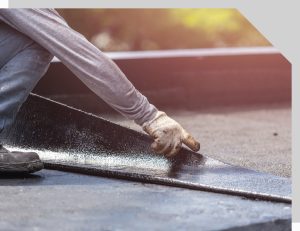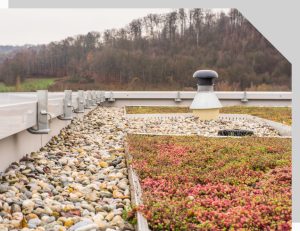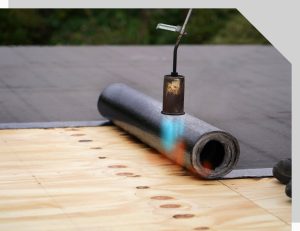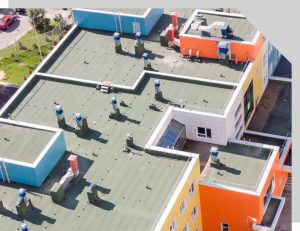Optimal Space and Modern Designs With Flat Roofing
If you’re looking to maximize your roof space, flat roofing is worth considering. Flat roofing has emerged as a preferred choice for both commercial and residential buildings, offering versatility, a long life expectancy, and added space to your property.
At Thunder Bay Roofing, our knowledgeable Edgewater roofing contractors have prepared a comprehensive guide that details the intricacies of flat roofing. Whether you’re contemplating a new flat roof or require a little maintenance for your current flat roof, our expertise has you covered. You can trust us for all your flat roofing needs.
Contact Thunder Bay Roofing for flat roofing solutions in your area by dialing 410-956-7663. You can also keep reading to learn more about the beauty of flat roofing.
What Is Flat Roofing?
Flat roofing is a distinctive roof type that features a horizontal or nearly horizontal surface with minimal to no slope. Unlike pitched roofs that exhibit a noticeable incline, a flat roof is characterized by its’ flat or low-sloped profile. Widely utilized for residential structures and most commercial buildings, flat roofing offers a level surface that safeguards the building and provides protection against the elements.
The installation methods and techniques employed for flat roofing may differ, but they all serve the common purpose of creating a seamless cover for your property. Trust Thunder Bay to deliver exceptional flat roofing solutions tailored to your needs.
Benefits of Flat Roofing
Flat roofing provides a range of benefits that make it a preferred new roofing option for many property owners in Edgewater, MD. Benefits of flat roofing include:
- Cost-Effective: Flat roofing is a cost-effective option, with simpler designs and fewer materials required for installation. This results in lower overall costs compared to sloped roofs.
- Versatility: Flat roofing provides design versatility, allowing for the incorporation of additional features like rooftop gardens, solar panel installations, or recreational spaces. The flexibility enhances the aesthetic appeal and functionality of the property.
- Accessibility: With a flat roof, accessing HVAC systems and air conditioning units, satellite dishes, and other equipment becomes easier, simplifying maintenance and repair tasks. The accessibility of flat roofs saves both time and effort.
- Energy Efficiency: Flat roofing systems have excellent insulation properties, which contribute to reduced energy consumption and lower heating and cooling costs. The energy efficiency of flat roofing positively impacts both the environment and your utility bills.
- Space Optimization: Make the most of the horizontal surface of a flat roof, as it provides additional usable space compared to sloped roofs. This extra space can be utilized for various purposes, optimizing the functionality of your building.
- Durability: The lifespan of a flat roof depends on factors such as material quality, installation techniques, climate conditions, and maintenance. On average, a well-maintained flat roof can last between 15 to 30 years. With proper care and periodic inspections, some flat roofs have even exceeded this lifespan.
Types of Flat Roofing and Flat Roofing Materials
There are various materials commonly used in flat roofing that tend to differ from traditional roofing materials, such as cedar and asphalt. The types of flat roofing systems available also tend to be highly unique.
Built-Up Roofing
Built-up roofing (BUR) is a widely used flat roofing material known for its longevity. It consists of multiple layers of roofing felt or fabric embedded in bitumen or asphalt. These layers are then completed with a protective top layer of gravel or mineral granules. A built-up roof offers excellent waterproofing capabilities and is resistant to UV rays, weathering, and foot traffic.
Single-Ply Membrane Roofing
Single-ply membrane roofing is a popular choice for flat roofing due to its lightweight and flexible nature. Single-ply roofing is available in two types:
- Thermoplastic olefin (TPO) roofing membranes are known for their energy efficiency and resistance to chemicals and UV radiation. They offer excellent durability and are available in a wide range of colors.
- Ethylene Propylene Diene Terpolymer (EPD) roofing membranes provide exceptional weather resistance, durability, and flexibility. They can withstand extreme temperatures, UV radiation, and environmental pollutants.
Modified Bitumen Roofing
Modified bitumen roofing is a versatile material specifically designed for flat roofs. It combines the durability of traditional BUR with the flexibility of a single-ply membrane. Made by mixing asphalt with synthetic rubber or plastic modifiers, it exhibits enhanced strength, flexibility, and resistance to extreme temperatures. Modified bitumen roofing is commonly installed in multiple layers, providing excellent longevity and ease of maintenance for flat roofs.
PVC Roofing
PVC (Polyvinyl Chloride) roofing is a highly favored choice for flat roofs due to its exceptional durability and resistance to various elements. Specifically engineered as a single-ply membrane for flat roof applications, PVC roofing offers superior performance. It features strong heat-welded seams that ensure reliable waterproofing.
PVC roofing is known for its energy-efficient properties, reflecting sunlight to reduce heat transfer and cooling costs. Its lightweight, flexible nature contributes to its popularity among flat roofing options, along with its extended lifespan.
Metal Roofing
Metal roofing materials, including steel or aluminum, are durable and enduring solutions well-suited for flat roofs. With its exceptional resistance to extreme weather conditions such as high winds, hail, and fire, metal flat roofs provide reliable protection. They’re lightweight, require minimal maintenance, and offer environmental benefits.
Types of flat metal roofing include:
- Standing Seam Flat Roofs: A standing seam metal roof is characterized by vertical metal panels that interlock along raised seams. These seams are raised above the level of the roofing panel surface, creating a distinct and aesthetically pleasing appearance. While a standing seam metal roof isn’t considered a traditional flat roof, it can be used on roofs with a low slope or even on roofs with steeper slopes.
- Corrugated Panel Metal Flat Roofs: Corrugated panel metal flat roofs feature horizontal metal panels with distinctive corrugations or ridges. Corrugated panel metal roofs offer effective waterproofing and weather resistance, ensuring protection against the elements.
- Metal Shingle Flat Roofs: Metal shingle flat roofs consist of individual metal shingles that mimic the look of traditional asphalt or slate shingles. They’re available in various styles, colors, and textures, allowing for customization and design flexibility. Metal shingles offer long-term performance, require minimal maintenance, and provide excellent protection against water infiltration and other elements.
Green Roofing
Green roofing, commonly called vegetative or living roofing, is a specialized system designed for flat roofs. It involves the installation of layered components that support plant growth on the roof surface. Green roofs offer numerous advantages specifically tailored to flat roofing, including enhanced insulation properties, reduced stormwater runoff, and improved air quality. A flat green roof can help mitigate the urban heat island effect and add aesthetic appeal to the building.
Spray Polyurethane Foam (SPF) Roofing
Spray polyurethane foam (SPF) or SPF roofing is a versatile and durable option specifically designed for flat roofs. It provides a seamless and durable roofing system by applying a liquid foam insulation material that solidifies. SPF roofs offer excellent insulation, reducing energy consumption and lowering heating and cooling costs. They create a monolithic barrier that eliminates joints and seams, ensuring superior waterproofing.
Despite being lightweight, SPF roofs are strong and are highly resistant to various weather conditions. They can be applied over existing roofing materials, making them cost-effective for renovations. SPF roofing is flexible, environmentally friendly, and ideal for flat roofs in need of insulation, waterproofing, and durability.
Asphalt Granule Flat Roof
An asphalt granule is a durable and affordable option, utilizing a layer of asphalt granules for protection. Applied on top of roofing materials like built-up roofing or modified bitumen membranes, the granules enhance UV resistance, weatherproofing, and fire resistance. Asphalt granule also offers customization options and comes in various colors. This waterproofing solution provides long-lasting protection against leaks and damage for both commercial and residential buildings.
Flat Roofing Maintenance and Repair Tips
Proper maintenance is crucial to ensuring the longevity and performance of your flat roof in Edgewater and surrounding areas. Some essential maintenance and repair tips include:
- Regular Inspections: Schedule regular inspections by a professional roofing contractor to detect any signs of damage or deterioration.
- Clear Debris: Remove leaves, branches, and other debris that can accumulate on the roof, as they can trap moisture and promote mold growth.
- Prompt Repairs: Address any issues, such as leaks or membrane damage, as soon as they are detected to prevent further damage.
- Gutter Cleaning: Keep rain gutters and downspouts clear of debris to ensure proper drainage and prevent water backup.
- Professional Maintenance: Utilize the services of a reputable roofing contractor like Thunder Bay Roofing for periodic maintenance, which may include resealing, reapplying protective coatings, or repairing any damage.
Are You Considering Flat Roofing?
Design and Aesthetic Appeal
Comparing traditional sloped roofs with flat roofs, the primary distinction lies in their design and aesthetic appeal. Sloped roofs boast a classic look with noticeable pitches, gables, and dormers, while flat roofs exude a modern and minimalist appearance with clean lines and a sleek, low-profile design.
Water Drainage
Sloped roofs enjoy a natural advantage when it comes to water drainage. The angled design allows rainwater and debris to flow effortlessly down and away from the structure, minimizing the risk of water pooling and potential leaks.
On the other hand, flat roofs necessitate careful consideration and proper installation of drainage systems. Without effective drainage, flat roofs may be susceptible to ponding water, which can cause structural damage and deterioration of the roof membrane. However, with appropriate slope and drainage solutions, flat roofs can effectively manage water runoff and mitigate potential issues.
Space Utilization
One significant advantage of flat roofs is the additional usable space they provide, a feature typically absent in sloped roofs. The level surface of a flat roof offers creative opportunities for rooftop gardens, energy-efficient solar panel installations, or the development of recreational areas. This extra space enhances the functionality and versatility of a building, making flat roofs an enticing choice for individuals seeking to optimize their available space and explore innovative design possibilities.
Cost and Installation
Flat roofs tend to be more cost-effective to install compared to sloped roofs. Their simpler design and requirement of fewer materials contribute to lower installation costs. The installation process for flat roofs is generally faster and requires less labor compared to the complex framing and shingling process involved in sloped roofs.
However, it’s crucial to consider factors such as the chosen roofing material, roof size, project complexity, and local market conditions, as they can affect the overall cost.
Maintenance and Repairs
Both flat roofs and sloped roofs require regular maintenance to ensure their longevity and performance. Flat roofs may necessitate more frequent inspections and maintenance to address potential issues such as membrane damage, clogged drains, or flashings. On the other hand, sloped roofs require maintenance tasks like shingle replacement and inspection of roof components. The specific maintenance needs depend on the roofing materials used and local climate conditions.
Consulting with a professional roofing contractor can help assess these factors and determine the most suitable roofing option for a specific building or project.
Frequently Asked Questions
On average, flat roofs can last anywhere from 15 to 30 years. The exact lifespan of a flat roof varies depending on the chosen material, quality of installation, maintenance, and environmental factors. Regular inspections, proper maintenance, and prompt repairs can extend the lifespan of a flat roof.
The cost of flat roofing can vary depending on the chosen material, roof size, complexity of the installation, and local market factors. While the initial installation cost of flat roofing materials may be comparable to or slightly higher than traditional sloped roofing, flat roofs offer long-term cost savings in terms of maintenance, energy efficiency, and additional space utilization.
Signs of flat roof damage may include leaks, visible cracks or blisters on the surface of the roof insulation, ponding water, mold growth, or an increase in energy bills. Conduct regular inspections and address any signs of damage promptly to prevent further deterioration and costly repairs.
Yes, flat roofs provide an ideal platform for solar panel installations. The horizontal surface allows for easy positioning and angling of solar panels to maximize sunlight exposure. Working with a roofing professional with experience in solar panel installations will ensure proper integration and waterproofing of the solar system with the flat roof.




